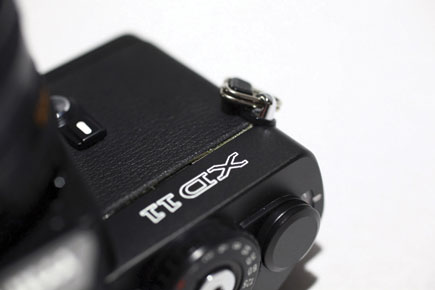Excellent camera, true classic. But leatherette is subject to shrinkage. I just replaced one and it looks like new again.
http://vkphotoblog.blogspot.ca/
Thanks
 |
 |
Later, Minolta painted the 125 setting on the shutter speed dial green to coincide with the green S indicator for Shutter-Priority and the green minimum f/stop setting. “Green for Go” became the new hastily cobbled catch phrase, and “ASC” became the new slogan. “It’s ‘Green for Go’ with Minolta XD’s Automatic Shutter-speed Compensation system (ASC)!” But you won’t find ASC mentioned in the early Owners Manuals. And the 125 marking on this anniversary XD-11 is not green in color.
Be that as it may, the Minolta XD-11 was a breakthrough product in many ways and deserves a place of honor in the camera Hall of Fame. In addition to being the world’s first Dual Mode camera, it was a masterpiece of technology and a brilliant piece of engineering. I remember a photo writer back then suggesting that future engineering students would study the XD-11 design as the archetype of how a camera should be built.
The XD offered a “full information viewfinder” that changed to accommodate shooting mode. Switch to Aperture-Priority and the shutter speeds appeared on the right-hand side. Set it to Shutter-Priority and you’d see the apertures. Clever. Plus the
f/stop was always visible at the bottom of the viewfinder thanks to a tiny physical window that peeked at the lens.
And a bright viewfinder it was. The Minolta XD cameras were the first to use the Acute Matte focusing screen, the same that was adopted by Hasselblad later. It featured a split-image rangefinder in the center surrounded by a remarkably sharp microprism collar. As I look through it now and manually focus I’m amazed at how easy it is. Subjects snap into focus with certainty.
The camera was built using a flexible printed circuit board (or “flex” as we called them internally). This was a major step toward the modular camera construction that dominates today. Shutter speeds were infinitely variable from 1 second to 1⁄1000 sec and there were two mechanical speeds, B and O. The first, of course, is the Bulb setting that holds the shutter open as long as the release is depressed. The latter position is 1⁄100 sec and was included as a safety precaution so that the camera could still be used even when the batteries died.
 |
Accessories included the Auto Electroflash 200X and the Auto Winder D. The winder attached directly to the camera base plate—no caps to remove or lose. As I recall, it could click along at about 2 frames per second with freshly charged NiCd batteries. The XD cameras accepted electronic remote releases or conventional cable releases because of a marvelous design that incorporated a double action cable release socket in the center of the shutter release.
The list of features goes on and on. For example, XD-11 users could make multiple exposures simply by pressing the rewind button on the camera’s bottom before advancing the thumb lever film advance. And of course, without advancing the film counter. Plus there was a small film advance indicator window on the back for peace of mind when not shooting multiple exposures.
Today the Minolta XD-11 is a solid gold fountain pen in a world where everyone uses a disposable BIC. That’s not a regressive slam against digital cameras. It’s recognition of the fact that scientific advances often make their technological parents obsolete. That said, this specimen is a stunning example of how little the outward appearance of SLR cameras has changed in three decades, despite the undeniable internal improvements. In “new old stock” condition, a 50th Anniversary black chrome Minolta XD-11 with a 50mm f/1.4 lens is worth approximately $500.
You can read Jon Sienkiewicz’s Blog at: www.shutterbug.com.

Excellent camera, true classic. But leatherette is subject to shrinkage. I just replaced one and it looks like new again.
http://vkphotoblog.blogspot.ca/
Thanks